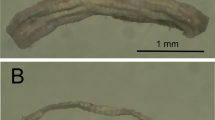Summary
A procedure is described which simplifies the classification of skeletal muscle fibres in that it allows a simultaneous evaluation of both the oxidative capacity and the intensity of “reversed” ATPase of the fibres, and thus enables to distinguish three fibre types — SO, FOG and FG — in one tissue section. After preincubation at pH 4.1–4.2 the cryostat section is incubated for succinate dehydrogenase (SDH) and subsequently for “reversed”-ATPase. This is followed by the fixation with neutral buffered formaldehyde. The results of typing of chicken, minipig and rabbit fibres in a single muscle section stained with this technique are identical to those obtained with the usual method based on a comparison of serial sections of which one is stained for SDH activity the other for “reversed”-ATPase activity.
Similar content being viewed by others
References
Asiedu S, Shafiq SA (1972) Actomyosin ATPase activity of the anterior latissimus dorsi muscle of the chicken. Exp Neurol 35:211–213
Ashmore CR, Doerr L (1971) Postnatal development of fiber types in normal and dystrophic skeletal muscle of the chick. Exp Neurol 30:431–446
Ashmore CR, Tompkins G, Doerr L (1972) Postnatal development of muscle fiber types in domestic animals. J Anim Sci 34:37–41
Ashmore CR, Vigneron P, Marger L, Doerr L (1978) Simultaneous cytochemical demonstration of muscle fiber types and acetylcholinesterase in muscle fibers of dystrophic chickens. Exp Neurol 60:68–82
Beermann DH, Cassens RG, Hausman GJ (1978) A second look at fiber type differentiation in porcine skeletal muscle. J Anim Sci 46:125–132
Brooke MH, Kaiser KK (1970) Three “myosin adenosine triphosphatase” systems: The nature of their pH lability and sulfhydryl dependence. J Histochem Cytochem 18:670–672
Butler J, Cosmos E (1981) Differentiation of the avian latissimus dorsi primordium: Analysis of fiber type expression using the myosin ATPase histochemical reaction. J Exp Zool 218:219–232
Curless RG, Nelson MB (1976) Developmental patterns of rat muscle histochemistry. J Embryol Exp Morphol 36:355–363
Davies AS (1972) Postnatal changes in the histochemical fibre types of porcine skeletal muscle. J Anat 113:213–240
Guth L, Samaha FJ (1970) Procedure for the histochemical demonstration of actomyosin ATPase. Exp Neurol 28:365–367
Gutmann E, Melichna J, Syrový I (1974) Developmental changes in contraction time, myosin properties and fibre pattern of fast and slow skeletal muscles. Physiol Bohemoslov 23:19–27
Lojda Z (1965) Remarks on histochemical demonstration of dehydrogenases. II. Intracellular localization. Folia Morphol 13:84–96
Meijer AEFH (1970) Histochemical method for the demonstration of myosin adenosine triphosphatase in muscle tissues. Histochemie 22:51–58
Micheau C (1974) Combined enzymatic reaction for nervous and muscular tissues. Stain Technol 49:195–197
Nemeth P, Hofer HW, Pette D (1979) Metabolic heterogeneity of muscle fibres classified by myosin ATPase. Histochemistry 63:191–201
Nemeth P, Pette D (1981) Succinate dehydrogenase activity in fibres classified by myosin ATPase in three hind limb muscles of rat. J Physiol 320:73–80
Padykula HA, Herman E (1955) The specificity of the histochemical method for adenosine triphosphatase. J Histochem Cytochem 3:170–195
Peter JB, Barnard RJ, Edgerton VR, Gillespie CA, Stempel KE (1972) Metabolic profiles of three fiber types of skeletal muscle in guinea pigs and rabbits. Biochemistry 11:2627–2633
Pette D, Spamer C (1979) Metabolic subpopulations of muscle fiber. A quantitative study. Diabetes 28 (Suppl 1):25–29
Reichmann H, Pette D (1982) A comparative microphotometric study of succinate dehydrogenase activity levels in type I, IIA and IIB fibres of mammalian and human muscles. Histochemistry 74:27–41
Sickles DW, McLendon RE, Rosenquist ThH (1982) Alternative method for quantitative histochemistry of muscle fibers. Application of photometric densitometry combined with atomic absorption spectrophotometry. Histochemistry 73:577–588
Spamer C, Pette D (1980) Metabolic subpopulations of rabbit skeletal muscle fibres. In: Pette D (ed) Plasticity of muscle. W de Gruyter, Berlin New York, pp 19–30
Stein JM, Padykula H (1962) Histochemical classification of individual skeletal muscle fibers of the rat. Am J Anat 110:103–123
Suzuki A, Cassens RG (1980a) pH sensitivity of myosin adenosine triphosphatase and subtypes of myofibres in porcine muscle. Histochem J 12:687–693
Suzuki A, Cassens RG (1980b) A histochemical study of myofiber types in muscle of the growing pig. J Anim Sci 51:1449–1461
Swatland HJ (1975) Histochemical development of myofibres in neonatal piglets. Res Vet Sci 18:253–257
Swatland HJ (1977a) Histochemical changes during muscle growth in pigs. Zbl Vet Med A 24:248–251
Swatland HJ (1977b) Transitional stages in the histochemical development of muscle fibres during post-natal growth. Histochem J 9:751–757
Toutant JP, Rouaud T, Le Douarin GH (1981) Histochemical properties of the biventer cervicis muscle of the chick: a relationship between multiple innervation and slow-tonic fibre types. Histochem J 13:481–493
Uhrín V, Kulíšek V (1979) Microscopic methods used in the evaluation of muscle growth and meat quality (in Czech). Institute report, Poutry Research Institute, Ivanka pri Dunaji
Van Den Hende C, Muylle E, Oyaert W, De Roose P (1972) Changes in muscle characteristics in growing pigs. Histochemical and electron microscopic study. Zbl Vet Med A 19:102–110
Ziegan J (1979) Kombinationen enzymhistochemischer Methoden zur Fasertypendifferenzierung und Beurteilung der Skeletmuskulatur. Acta Histochem 65:34–40
Zíka K, Lojda Z, Kučera M (1973) Activities of some oxidative and hydrolytic enzymes in musculus biceps brachii of rats after tonic stress. Histochemie 35:153–164
Author information
Authors and Affiliations
Rights and permissions
About this article
Cite this article
Horák, V. A successive histochemical staining for succinate dehydrogenase and “reversed”-ATPase in a single section for the skeletal muscle fibre typing. Histochemistry 78, 545–553 (1983). https://doi.org/10.1007/BF00496207
Received:
Accepted:
Issue Date:
DOI: https://doi.org/10.1007/BF00496207




